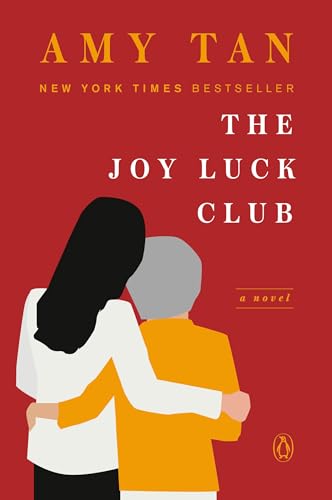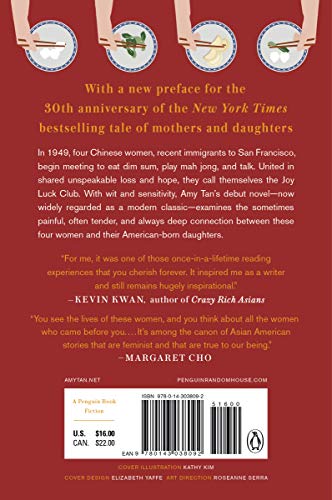Welcome to my review of The Joy Luck Club. This book took me on a rollercoaster of emotions, much like the time my cat got stuck in the ceiling. It’s a heartwarming and sometimes hilarious journey through mother-daughter relationships and the magic of storytelling. We’ll dive into the cultural identity, heritage, and generational conflicts that make this novel an unforgettable read. So, grab a snack, and let’s get into it!
In a nutshell
The Joy Luck Club is a classic novel by Amy Tan. It’s a beautiful blend of fiction and cultural themes, diving into the lives of Chinese-American families. The book explores mother-daughter relationships, cultural identity, and the clash between generations. Magic happens through storytelling as the characters learn about themselves and each other. It’s a heartfelt journey packed with emotion, humor, and tender moments.
Exploring Mother-Daughter Dynamics in Literature: Lessons from The Joy Luck Club
Mother-daughter relationships can be a roller coaster ride, filled with love, misunderstandings, and those classic “I told you so” moments. No book captures this better than “The Joy Luck Club” by Amy Tan. Each page unwraps the complexities of these relationships like a box of chocolates—sometimes sweet, sometimes bitter, but always rewarding.
In “The Joy Luck Club,” Tan introduces us to four immigrant Chinese mothers and their American-born daughters. Each relationship is a dance of cultural clashes and generational differences. I once tried to teach my mom how to use the latest smartphone. Imagine that scene as a metaphor for the entire book. It’s all in the effort and the misunderstandings. But, like my mom finally using emojis, it ends with heartfelt understanding.
One can’t help but laugh and cry when reading about the daughters trying to navigate their own paths while honoring their mother’s wisdom. I remember a time when my own mom “advised” me to wear a sweater—I ignored her, and of course caught a cold. That’s the essence of these stories: you fight, you learn, you love.
However, the book isn’t perfect. Its many narratives can get a tad complicated. Keeping track of who’s who sometimes had me flipping back pages like a detective in search of clues. Despite that, it’s worth every minute you invest.
In our next section, we will unravel how cultural identity and heritage shape these relationships. It’s like unraveling the mystery of the fortune cookie. Stay tuned!
Exploring Cultural Identity and Heritage in ‘The Joy Luck Club’
When it comes to cultural identity and heritage, I often think about my own family reunions. Picture this: my Grandma trying to teach me the traditional family soup recipe, only for me to accidentally turn it into something that tastes like bathwater. But this blend of past and present is what makes our identities so unique, and it’s exactly what ‘The Joy Luck Club’ portrays so vividly.
In Amy Tan’s novel, the story unfolds through the eyes of four Chinese-American daughters and their immigrant mothers. Each storyline is like a jigsaw piece, contributing to a larger picture of shared identity marked by cultural collisions. These women battle with the tug-of-war between maintaining their Chinese roots while adapting to American society. It’s like trying to dance to two different songs at once—confusing but somehow meaningful.
While reading, I couldn’t help but chuckle when I found myself relating to Waverly Jong’s struggles with her mother. The game of chess in their relationship isn’t just a board game but a metaphor for navigating the complexities of cultural and generational chessboards. Tan does an excellent job of illustrating how identity isn’t something you receive like a medal but a mosaic you painstakingly piece together.
Sure, some parts of the novel rambled like my Uncle Bob’s tales at Thanksgiving. But overall, it hits home with its honest portrayal of cultural identity. Next up, brace yourself for a wild ride into the world of intergenerational conflict, where the sparks really start to fly!
Intergenerational Conflict in Literature: Insights from ‘The Joy Luck Club’
When I think of intergenerational conflict, my mind jumps straight to The Joy Luck Club by Amy Tan. You know, like when you’re trying to teach your grandma how to use an iPhone, but with much deeper emotional stakes. This book does a fantastic job showing the wrinkles and layers in mother-daughter relationships, especially the tug-of-war between Chinese immigrant mothers and their American-born daughters. I remember laughing, crying, and then laughing again all in the same paragraph. What a ride!
The mothers in the novel often bring with them a suitcase full of cultural expectations. Meanwhile, the daughters are busy trying to chase that American Dream. It’s like watching a game of cultural tennis, and you can’t help but wonder: who’s winning? In the end, neither side scores all the points, and that’s what makes it so relatable. But let’s not forget the humor! I mean, the mothers’ attempts to understand their daughters’ way of life? Priceless! It’s like my mom trying to get TikTok—hilarious and heartwarming.
There are certainly moments where I found myself caught between empathizing with the mothers’ traditional values and rooting for the daughters’ modern perspectives. Amy Tan brilliantly weaves these conflicts into a tapestry of rich storytelling. These characters are so well-written that you’ll find pieces of your own family dilemmas within their narratives.
Now that we’ve untangled the knots of intergenerational conflict, let’s move on to another charming theme: The power of storytelling, where tales become bridges between generations!
The Power of Storytelling: A Journey Through The Joy Luck Club
Storytelling is a magical art. It pulls you into a world woven with words and emotions. It’s like crafting a cozy blanket of tales to wrap yourself in. In Amy Tan’s The Joy Luck Club, storytelling is the glue binding generations. Powerful tales leap off the pages. They touch hearts of readers like a warm hug from grandma. My friend Sarah and I once shared a similar awe, discussing tales from our family roots.
The book tells the stories of four Chinese-American immigrant families in San Francisco. Each mother and daughter duo possesses a unique story. They portray a cultural tapestry of individual and shared experiences. Each tale is like a puzzle piece. You place them together and see the big picture of the family legacy.
Storytelling is more than a narrative. It preserves traditions and values, connects generations, and bridges gaps of understanding. I remember sitting around the campfire, listening to my uncle’s stories. He’d narrate tales of our ancestors, and suddenly I’d feel so close to my heritage. The same magic flows through The Joy Luck Club. It shows how stories shape identities and nurture relationships.
And let’s be honest, there are no spells or magic wands. Yet, stories spellbind us. They help us navigate life’s twists and turns. The book taught me that listening is as essential as telling. It’s a two-way street that keeps the storytelling wheel spinning.
Would I recommend The Joy Luck Club? Absolutely! Like a delicious cupcake, it’s full of surprises and sweet insights. So grab a copy, settle in, and enjoy the ride.
Conclusion
Concluding my review of ‘The Joy Luck Club’, Amy Tan crafts a touching tale of mother-daughter bonds, cultural identity, and generational conflict. The stories weave together like a mismatched quilt, each piece unique yet fitting perfectly. As a reader, I laughed, I cried, and occasionally questioned my own family dynamics. While some might find its structure a bit tangled, those who embrace it will find it an emotional, rewarding ride. If you’re up for a journey through humor and heartache, this book is a worthwhile companion.



